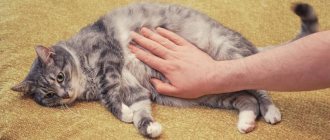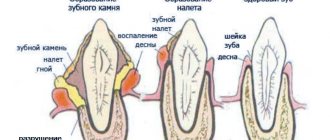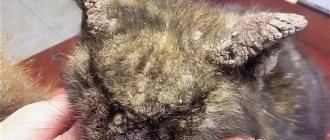A common cause of severe coughing in cats is asthma. It is a chronic inflammatory disease of the respiratory tract. A characteristic feature of this condition is the narrowing of the bronchi, which causes the animals to experience periods of prolonged dry cough. Experts from the Berloga veterinary clinic in Moscow talk about how to promptly recognize asthma in cats, and whether this disease can be completely cured.
Read in this article:
Why do cats develop asthma? Signs of asthma: what should the owner pay attention to? How does the disease develop? Diagnosis of asthma: methods and nuances Treatment of asthma in cats Recommendations for the owner How long do cats with asthma live? Disease prevention
Why do cats develop asthma?
Asthma most often develops in cats between the ages of 2 and 8 years. It is less common in kittens or older animals, but can still develop. The main causes of asthma in furry pets include:
- Allergy . In 70% of cases, the disease develops due to exposure to allergens. The most common factors that cause allergic reactions in cats of different ages include pollen, medications, food, litter trays and even cigarette smoke. Continuous or frequent exposure to allergens inevitably leads to the sensitivity of the animal’s lungs increasing significantly, and this entails the occurrence of asthma;
- Oncology . The next reason that can lead to the development of chronic respiratory tract disease in a cat is malignant neoplasms affecting the lung tissue. To find out whether asthma is caused by cancer, a chest x-ray is required during diagnosis. If malignant tumors are detected, their removal is prescribed. Only in this case will the cat’s condition be stabilized;
- Diseases of the respiratory system . Incompletely cured infections affecting the respiratory tract lead to weakened immunity of animals and provoke the development of repeated inflammatory processes in the bronchi. These include pneumonia (inflammation of the pulmonary alveoli), rhinotracheitis (herpes virus infection), cat flu, etc. As a result, a chronic disease develops - asthma.
Another reason that can cause asthma in indoor or outdoor cats is genetics. If we consider the hereditary factor, then the risk group most susceptible to the development of this disease is identified - Siamese and Himalayan cats.
On a note! For asthma to be passed on to offspring, one sick parent is enough. This fact must be taken into account when breeding cats.
Signs of asthma: what should the owner pay attention to?
The first thing that indicates asthma in a cat is a cough. At the same time, furry pets bend their paws and stretch their necks. The cough is quite strong and protracted, reminiscent of regurgitation of fur, so some owners ignore this symptom, attributing it to the animal’s normal behavior.
Symptoms of bronchial asthma in a cat:
- sudden coughing fits of varying duration,
- dyspnea,
- labored breathing,
- wheezing,
- fast fatiguability,
- lethargy,
- refusal of games and activities,
- loss of appetite.
In severe cases of asthma, oxygen deficiency (hypoxia) occurs. The level of oxygen in the body decreases, and the mucous membranes turn blue - cyanosis develops. In this case, immediate veterinary attention is required.
Symptoms
The most obvious sign of asthma in a kitten is the appearance of wheezing and frequent coughing. The cat often breathes with its mouth open: it is difficult for her to inhale and exhale. A typical coughing position is a squatting position with the neck extended. After several days of attacks, the cat experiences a depressed and depressed state, loss of appetite, and drowsiness. The pet’s lifestyle changes significantly: less time for games and exploring the world around him, more time for sleep and apathy.
When the disease reaches its peak, the mucous membranes become bluish due to oxygen deprivation (cyanosis). The pulse increases, the cough is already painful and may be accompanied by a plaintive meow, the nose and lips turn pale, and the body temperature becomes slightly below normal. During an attack, the cat will not respond to its name; cases of aggression and anxiety, loss of consciousness are quite possible. If these symptoms are detected, you should immediately seek help from a veterinary clinic.
Read about choosing a clinic: How to choose the right veterinary clinic for a cat
How does the disease develop?
Asthma in cats develops gradually. It usually begins with a mild form, in which the frequency of coughing attacks is about 1-2 times a month. Many owners ignore this or simply lose sight of it when they are away from home (for example, at work or school). In the first stage of asthma, the cough lasts about 40-60 seconds, so the cat recovers quickly without outside help.
If you do not take any countermeasures at this stage and do not consult a doctor, the disease will continue to develop. This will entail an increase in the duration of coughing attacks, as well as the appearance of other symptoms (fatigue, loss of appetite, strange wheezing, etc.). You shouldn’t write off all these symptoms “at random” - this can lead to serious consequences, including suffocation.
How to use a spacer?
Since asthma requires the most long-term treatment, the cat must be introduced to the spacer gradually. To prevent frequent inhalations from being stressful for the animal, which has a detrimental effect on the animal’s body, aggravating the course of asthmatic attacks, it is necessary to show the cat that this procedure is absolutely painless and safe. First, show the animal the mask, let it sniff, and then in a calm environment or play, place the mask on its face for a few seconds. Repeat these manipulations several times, gradually increasing the procedure time. Once your animal gets used to the mask, carefully connect the camera without injecting medication into it. Continue applying the spacer to the cat's nose until she gets used to it and begins to breathe calmly through it, while not forgetting to encourage the animal with your voice or stroking. Then you can use AeroKat with the necessary medicine. During inhalation, it is necessary to count the movements of the valve; on average, the cat should take about 5-8 breaths of the medicine.
Diagnosis of asthma: methods and nuances
The main rule is not to diagnose and treat asthma on your own! The fact is that this can distort the results of upcoming studies, confuse the veterinarian and worsen the already serious condition of your beloved pet.
On a note! There are no laboratory tests that can detect asthma with 100% certainty.
To make an accurate diagnosis, the veterinarian examines the pet, asks the owner several questions (how often coughing attacks occur, how long do they last, are there any other changes in the animal’s behavior), and also prescribes additional examinations:
- general blood analysis,
- radiography,
- bronchoscopy,
- cytological examination.
The results of these studies make it possible to differentiate asthma in cats from other diseases that have similar symptoms (for example, chronic bronchitis, malignant neoplasms, pneumonia).
Diagnostics in a veterinary clinic
Diagnosis of asthma is based on differentiating it from other respiratory tract pathologies that have a similar clinical picture - pneumonia, bronchitis, pulmonary failure.
In addition, heart disease, benign and malignant tumors in the chest area, nematodes in the lungs, and foreign objects entering the respiratory tract, including trichobezoars, must be excluded.
The veterinarian needs to conduct the following tests:
- General blood analysis. An allergic process will be indicated by an increased level of eosinophils.
- Stool analysis (if nematodes are suspected).
- X-ray. It does not apply to specific diagnostic methods, but it allows identifying the displacement of the diaphragm towards the abdominal cavity, characteristic of asthma.
The most informative criterion is cytological analysis of bronchial mucus. In asthma, it is always thick, forming plugs in the respiratory tract, cloudy, with a greenish tint.
Treatment of asthma in cats
Unfortunately, asthma has no cure. However, this is not a reason to do nothing and give up. Veterinary clinic specialists know how to control and prevent sudden coughing attacks that develop against the background of asthma.
One of the main tasks is to identify and eliminate allergens that lead to a deterioration in the pet’s condition. If asthma is triggered by allergic reactions, which are a common cause of the disease, then eliminating allergens will completely prevent attacks of prolonged asthmatic cough.
If the signs of asthma cause severe discomfort to the pet or his body is so weakened that it cannot fight the disease even if allergens are excluded, drug therapy is prescribed. The veterinarian assesses the pet’s condition and, based on the diagnostic results, prescribes medications:
- Bronchodilators (bronchodilators) . They are designed to quickly relieve asthma symptoms. They act by expanding the lumen of the bronchi, making breathing much easier. Typically, bronchodilators are prescribed by a veterinarian along with anti-inflammatory drugs - this ensures maximum effectiveness of treatment;
- Glucocorticosteroids . Hormonal drugs that help increase blood glucose levels. They are prescribed by veterinarians carefully, taking into account all the characteristics of the pet’s condition. Glucocorticosteroids increase glycogen production in the liver and enhance protein catabolism. However, their intake must be strictly controlled;
- Antibiotics . Prescribed during periods of exacerbation as an addition to the main therapeutic program. Antibiotics are intended to control secondary flora and eliminate bronchospasms. They are often used if asthma is caused by incompletely treated infections;
- Antihistamines . They relieve various signs of allergic reactions and prevent their development. Each cat will respond differently to a particular antihistamine, so in some cases it may be necessary to try multiple treatment options;
- Vitamin and mineral complexes . They contain vitamins and minerals necessary for the rapid restoration of the animal’s body, strengthening the immune system, returning physical activity and appetite. Such complexes speed up recovery and reduce the risk of complications.
Trust the treatment of bronchial asthma in a cat only to experienced veterinarians!
Recommendations for the owner
Always have a first aid kit on hand to provide emergency assistance. Include in it all the medications that the doctor recommends (glucocorticosteroids, bronchodilators, antihistamines, etc.). These products, along with your veterinarian's prescriptions, should always be available so you can use them immediately.
Discuss with your veterinarian the possibility of using bronchodilators or other aerosol medications. Using inhalers with special attachments is much more convenient and, most importantly, faster. This means you can quickly eliminate the attack and reduce the risk of side effects when using steroids in tablet or injection form.
Anti-inflammatory therapy
It is necessary in order to relieve inflammation, reduce hypersecretion and swelling from the bronchi. For this purpose, various forms of glucocorticoids are used, which are selected individually for the animal:
- Inhalation (Fluticasone propionate);
- Injectable (Dexamethasone, Prednisolone);
- Tablets (Prednisolone, Methylprednisolone);
- Bronchodilators are drugs that relax the bronchial wall, thus relieving bronchospasm. These drugs are most often used in the form of inhalers and/or in combination with steroids (albuterol).
Fig.2. Spacer.
To administer inhaled drugs, special devices are used - spacers. A spacer is a special auxiliary device for inhalation. The spacer chamber serves as an intermediate reservoir for the aerosol. On one side of the chamber there is a mask that is tightly applied to the cat’s nose, and on the other there is a hole for the inhaler. The medicine from the can enters the spacer chamber and is then inhaled by the cat. For inhalations, it is better to use a special cat spacer, AeroKat, since its mask is best suited for animals. It is also equipped with a valve, with which it is possible to visually assess the number of breaths taken by the cat. The use of children's analogues is also allowed.
Disease prevention
It will not be possible to achieve a complete recovery of an animal with asthma, so your main task as the owner is to protect the pet from possible attacks of prolonged coughing. To do this, just follow simple recommendations from experienced veterinarians:
- carry out wet cleaning frequently,
- ventilate the rooms regularly,
- do not allow dust to accumulate,
- think about choosing a humidifier,
- use powders and other household products from the “Eco” category,
- carefully monitor your pet's diet,
- move house flowers and plants to the balcony - if possible,
- do not smoke indoors,
- choose non-dusty litter for the tray.
Remember that the life and health of your pet is in your hands!










